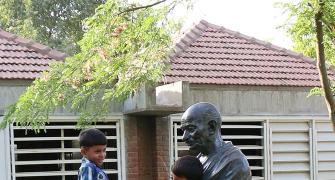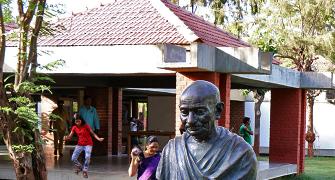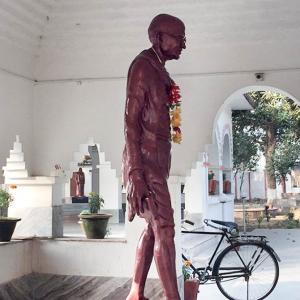'I cannot afford to go to court. I cannot afford to lose a case. I will fight the Gandhi way -- peacefully, non-violently, and with determination,' Purshottam Chauhan, a resident of the Sabarmati Ashram, tells Rosamma Thomas.
Around him, the homes of former neighbours are rubble.
About 300 Dalit families resided within the premises of the Sabarmati Ashram till 2021.
Only about 40 now remain.

Seventy-four-year-old Purshottam Chauhan is among the last people refusing compensation and insisting on not moving from his home at the Sabarmati Ashram at Ahmedabad.
"We are a family of 12, with grandchildren from my three sons; we have lived in this area very happily for a long time. No government-provided flat can accommodate us all as comfortably as the home we now have. I have not accepted compensation and do not intend to move," Chauhan says.
One wall of the two-storey family home was bulldozed. Despite the pressure, the family stays put.
"I cannot afford to go to court. I cannot afford to lose a case. I will fight the Gandhi way -- peacefully, non-violently, and with determination," he adds.
Around him, the homes of former neighbours are rubble. About 300 Dalit families resided within the premises of the Sabarmati Ashram till 2021. Only about 40 now remain.

In 1930, when Mahatma Gandhi set out on the 384 km Salt March to Dandi from the Sabarmati Ashram, he vowed that he would not return there until India gained independence.
He later moved to Wardha in Maharashtra, and bequeathed the Ashram at Sabarmati to Dalits, whom he referred to as 'Harijans'.
The Dalit families that came to settle in this area, some of whom can trace their forefathers to the people who first moved there when the Ashram was set up in 1917, were known as Ashram wasis.
In August 2021 the Narendra Modi-led government at the Centre decided that the Gandhi Ashram would get a Rs 1,200 crore (Rs 12 billion) makeover, to become the 'most significant memorial to Gandhi in the world'.
Dalit residents were offered compensation, and could choose either a flat or a sum of Rs 60 lakh (external link) to relocate elsewhere.
This project too, like the Sabarmati Riverfront Project and the Central Vista in New Delhi, is being executed by HCP Design, Planning and Management Private Limited, a firm headed by Bimal Patel, an architect with a history of close association with Modi.
The firm's Web site (external link) does not yet have information on this project, although it lists several others undertaken in the Modi regime.
About 700,000 visitors from around the world arrive at the Ashram each year, and the Modi government is all set to 'monetise' tourist inflow, although Gandhians have pointed out that the site is special to India's history, and to 're-develop' it into a tourism spot would be a major departure from the ideals of the spartan Gandhi.

Gandhi's grandson and historian Rajmohan Gandhi, Justice A P Shah, former chief justice of the Delhi high court, and Aruna Roy of the Mazdoor Kisan Shakti Sanghatan were among over hundred others who issued a statement warning of the loss of important archival material: '...the most frightening aspect is government control over all Gandhian archives. As Mahatma Gandhi was murdered by elements whose ideology still inspires some of those in power in India, this danger cannot be overlooked.'
The statement warned that the government plan could be a 'second assassination' of Gandhi.
At the Sabarmati Ashram, a museum space designed by architect Charles Correa, completed in 1963, showcases important letters and photographs.
Among the exhibits is the letter Gandhi wrote, seeking that Harijan families be accommodated in Sabarmati Ashram.
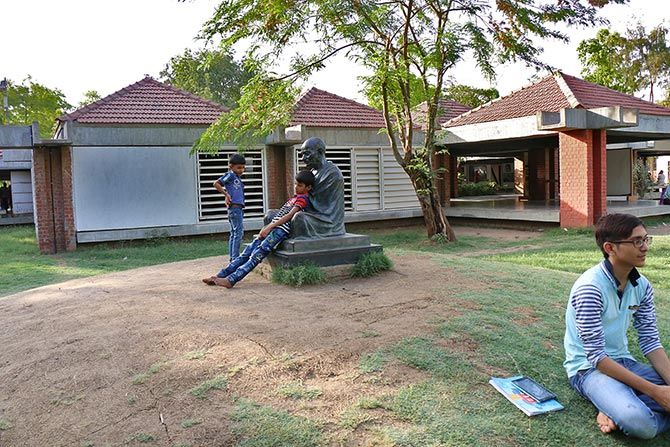
About 300 families lived in the 100-acre premises of the Ashram, on both sides of Ashram Road in Ahmedabad, a road that spliced through Ashram land.
Urban planners had earlier sought that both sides of the Ashram, spread on either side of the road, be 'reunited'.
News magazine Frontline reported that the plan for the area includes re-routing the arterial Ashram Road.
As the city expanded, more and more land was taken from the Ashram, until what now remains as the core Ashram area is only about five acres on the bank of the Sabarmati.
The tenements of the Dalits, spread across the 100-acre area, have mostly been razed, and the rubble was still strewn around when this reporter visited in February 2023.
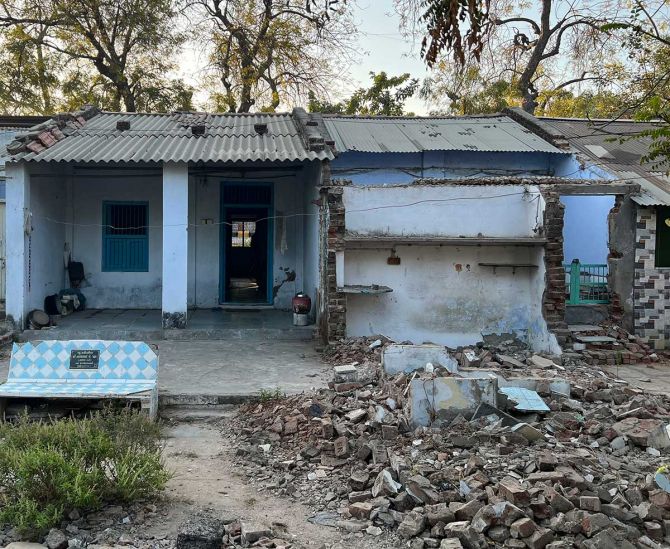
About 40 families remain of the nearly 300 that stayed in the Ashram.
Parth Chauhan, a young resident who runs a small restaurant in the area, is determined to hold on to his family home.
"When people feel they will lose their home anyway, and it would be practical to just accept compensation and move, what can be done?" he asks.
"Had the Ashram wasis all stood as one and refused to move, we might have stood a better chance of having our voices heard. When one family accepts compensation and moves, the administration swiftly destroys the house here so the option of returning is closed," he adds.
Chauhan explains that those who had accepted compensation had regrets: "Those who accepted money now realise that even with one crore (Rs 10 million) it would be hard to buy land in this area and build a house. We do not need the money; we have a life of dignity here."

Jaysukhlal, who worked as a carpenter manufacturing the looms on which cloth was woven at the Ashram, also appears forlorn that he was forced to accept compensation.
Even as this reporter visited, some former residents returned to spend time at the local temple, which had served as a place of worship for about three generations.

Uday Singh Rathore, a resident who went to school in the area and described how even the buttons on his school uniform were from the woven cloth bunched together, and given to him and his schoolmates free from the Ashram, said he had received compensation for a house which he had only recently renovated at massive expense.
He also had another plot on which he had not constructed anything, for lack of funds -- the government has refused to offer compensation for the plot, claiming that only people with houses were entitled to it.
Besides, the land was acquired as a collective, and a sum of Rs 203,150 had been paid in 1998, after collections were made from over 30 other families.
He had no document to show personal ownership, and the government was refusing to accept documents he held, showing the transfer of the land to the collective.

Ashram residents were earlier promised jobs in the area, but there is now no talk of such compensation; residents were also not aware of the plans of the government for the land that would be acquired from them.
Vikram Parmar, who has accepted compensation but often visits his old home, says people accepted the money in fear that they would eventually be left without even that, if they refused.
Parth Chauhan explains that those who agreed to move were housed in high-rise, expensive apartments.
"When the lift goes kaput, there is a huge expense involved. We are not people who can afford such high maintenance costs. It is best for us to live close to the ground."
Although Dalit residents are being displaced, Manav Sadhana, an NGO run by Jayesh Patel (external link), married to Anar, the daughter of UP Governor Anandiben Patel (external link), who earlier served as Gujarat chief minister, has taken up space right at the front of the Ashram, and showcases its work to visitors.
The NGO Web site seeks donations for its work among lower caste families.
Attempts by this reporter to reach officials of the Ahmedabad Municipal Corporation on the phone for responses to questions raised by the displaced were not successful.
Feature Presentation: Ashish Narsale/Rediff.com
1

